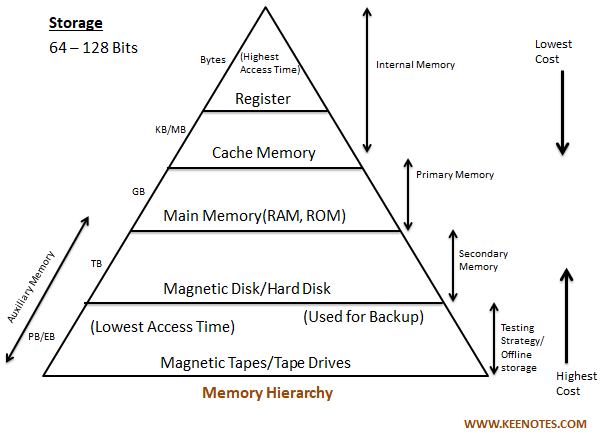
Memory Hierarchy is a modification used in computer system design to better organise memory and reduce access times.
The following diagram exemplifies many memory hierarchy types:
- CPU Registers
- Cache Memory
- Main Memory
- Magnetic Disk
- Magnetic Tapes/Tape Drives

1) Registers
- Directly Communicate with CPU
- It is a static RAM in computer processor
- CISC have many register for accepting main memory
- RISC have more registers
- Assigned a memory address or instruction or any data
2) Cache Memory
- Static RAM
- It may be an IC Separated into levels
- Holds chunk of data which are frequently used from main memory
3) Main Memory
- Dynamic RAM/ROM
- Fast & Large
- Store data throughout the operation
- Stores programs & data when they are processed
- Nothing permanently kept here
- Every program we execute & every file we access must be copied from storage into main memory.
- Mainly read/write is done
- Provide Multiprocessing environment
4) Magnetic Disks
- Write/Rewrite/Access data
- Entire disk is divided into platters, each consists of circles called tracks.
- Each track divided into sectors(ie smallest division in disk)
5) Magnetic Tape
- Magnetic tape refers to a normal magnetic recording designed with a slender magnetizable overlay that covers an extended, thin strip of plastic film.
- It is used mainly to back up huge chunks of data. When a computer needs to access a strip, it will first mount it to access the information.
- Once the information is allowed, it will then be unmounted.
- The actual access time of a computer memory would be slower within a magnetic strip, and it will take a few minutes for us to access a strip.
Auxillary Memory
- It is non volatile
- Lowest cost, highest capacity & slowest access storage
- Program & Data kept for long time
- Example Magnetic Tapes & Disks, Papertapes
- Has Data Stability
- Work like ROM
Associative Memory
- Data cannot be identified by address or memory location
- Also called Content Addressable Memory(CAM) ie. its data is only identified by the content of data itself.
Virtual Memory
- Uses hardware or software to allow a computer to compensate for physical memory storage by temporarily transferring data from RAM to Disk.
- Used when computer memory(RAM) run out of storage. It uses a section of hard drive.
- It is managed by memory management unit(MMU)
Memory Management Hardware
- Resides in hardware, in operating system & program & applies
- Involves RAM, memory caches, Flash based SSD
- Involves allocation of specific memory blocks to individual program as user demands change
#Cache Memory #Magnetic Disk #Magnetic Tapes #Main Memory #memory hierarchy #registers